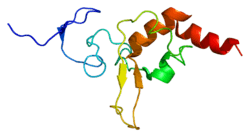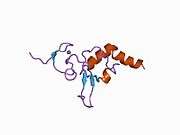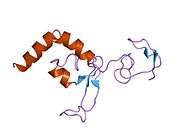XPA
| View/Edit Human | View/Edit Mouse |
DNA repair protein complementing XP-A cells is a protein that in humans is encoded by the XPA gene.[3]
Interactions
XPA has been shown to interact with ERCC1,[4][5] Replication protein A1[6] and XAB2.[7]
References
- ↑ "Human PubMed Reference:".
- ↑ "Mouse PubMed Reference:".
- ↑ "Entrez Gene: XPA xeroderma pigmentosum, complementation group A".
- ↑ Li L, Elledge SJ, Peterson CA, Bales ES, Legerski RJ (May 1994). "Specific association between the human DNA repair proteins XPA and ERCC1". Proceedings of the National Academy of Sciences of the United States of America. 91 (11): 5012–6. doi:10.1073/pnas.91.11.5012. PMC 43920
 . PMID 8197174.
. PMID 8197174. - ↑ Nagai A, Saijo M, Kuraoka I, Matsuda T, Kodo N, Nakatsu Y, Mimaki T, Mino M, Biggerstaff M, Wood RD (Jun 1995). "Enhancement of damage-specific DNA binding of XPA by interaction with the ERCC1 DNA repair protein". Biochemical and Biophysical Research Communications. 211 (3): 960–6. doi:10.1006/bbrc.1995.1905. PMID 7598728.
- ↑ Li L, Lu X, Peterson CA, Legerski RJ (Oct 1995). "An interaction between the DNA repair factor XPA and replication protein A appears essential for nucleotide excision repair". Molecular and Cellular Biology. 15 (10): 5396–402. doi:10.1128/mcb.15.10.5396. PMC 230789
 . PMID 7565690.
. PMID 7565690. - ↑ Nakatsu Y, Asahina H, Citterio E, Rademakers S, Vermeulen W, Kamiuchi S, Yeo JP, Khaw MC, Saijo M, Kodo N, Matsuda T, Hoeijmakers JH, Tanaka K (Nov 2000). "XAB2, a novel tetratricopeptide repeat protein involved in transcription-coupled DNA repair and transcription". The Journal of Biological Chemistry. 275 (45): 34931–7. doi:10.1074/jbc.M004936200. PMID 10944529.
Further reading
- Cleaver JE, Thompson LH, Richardson AS, States JC (1999). "A summary of mutations in the UV-sensitive disorders: xeroderma pigmentosum, Cockayne syndrome, and trichothiodystrophy". Human Mutation. 14 (1): 9–22. doi:10.1002/(SICI)1098-1004(1999)14:1<9::AID-HUMU2>3.0.CO;2-6. PMID 10447254.
- Morikawa K, Shirakawa M (Aug 2000). "Three-dimensional structural views of damaged-DNA recognition: T4 endonuclease V, E. coli Vsr protein, and human nucleotide excision repair factor XPA". Mutation Research. 460 (3-4): 257–75. doi:10.1016/s0921-8777(00)00031-8. PMID 10946233.
- Satokata I, Tanaka K, Okada Y (Mar 1992). "Molecular basis of group A xeroderma pigmentosum: a missense mutation and two deletions located in a zinc finger consensus sequence of the XPAC gene". Human Genetics. 88 (6): 603–7. doi:10.1007/BF02265282. PMID 1339397.
- Satokata I, Tanaka K, Yuba S, Okada Y (Mar 1992). "Identification of splicing mutations of the last nucleotides of exons, a nonsense mutation, and a missense mutation of the XPAC gene as causes of group A xeroderma pigmentosum". Mutation Research. 273 (2): 203–12. doi:10.1016/0921-8777(92)90081-d. PMID 1372103.
- Miyamoto I, Miura N, Niwa H, Miyazaki J, Tanaka K (Jun 1992). "Mutational analysis of the structure and function of the xeroderma pigmentosum group A complementing protein. Identification of essential domains for nuclear localization and DNA excision repair". The Journal of Biological Chemistry. 267 (17): 12182–7. PMID 1601884.
- Satokata I, Tanaka K, Miura N, Miyamoto I, Satoh Y, Kondo S, Okada Y (Dec 1990). "Characterization of a splicing mutation in group A xeroderma pigmentosum". Proceedings of the National Academy of Sciences of the United States of America. 87 (24): 9908–12. doi:10.1073/pnas.87.24.9908. PMC 55283
 . PMID 1702221.
. PMID 1702221. - Miura N, Miyamoto I, Asahina H, Satokata I, Tanaka K, Okada Y (Oct 1991). "Identification and characterization of xpac protein, the gene product of the human XPAC (xeroderma pigmentosum group A complementing) gene". The Journal of Biological Chemistry. 266 (29): 19786–9. PMID 1918083.
- Tanaka K, Miura N, Satokata I, Miyamoto I, Yoshida MC, Satoh Y, Kondo S, Yasui A, Okayama H, Okada Y (Nov 1990). "Analysis of a human DNA excision repair gene involved in group A xeroderma pigmentosum and containing a zinc-finger domain". Nature. 348 (6296): 73–6. doi:10.1038/348073a0. PMID 2234061.
- Li L, Lu X, Peterson CA, Legerski RJ (Oct 1995). "An interaction between the DNA repair factor XPA and replication protein A appears essential for nucleotide excision repair". Molecular and Cellular Biology. 15 (10): 5396–402. doi:10.1128/mcb.15.10.5396. PMC 230789
 . PMID 7565690.
. PMID 7565690. - Nagai A, Saijo M, Kuraoka I, Matsuda T, Kodo N, Nakatsu Y, Mimaki T, Mino M, Biggerstaff M, Wood RD (Jun 1995). "Enhancement of damage-specific DNA binding of XPA by interaction with the ERCC1 DNA repair protein". Biochemical and Biophysical Research Communications. 211 (3): 960–6. doi:10.1006/bbrc.1995.1905. PMID 7598728.
- Farndon PA, Morris DJ, Hardy C, McConville CM, Weissenbach J, Kilpatrick MW, Reis A (Sep 1994). "Analysis of 133 meioses places the genes for nevoid basal cell carcinoma (Gorlin) syndrome and Fanconi anemia group C in a 2.6-cM interval and contributes to the fine map of 9q22.3". Genomics. 23 (2): 486–9. doi:10.1006/geno.1994.1528. PMID 7835901.
- Park CH, Mu D, Reardon JT, Sancar A (Mar 1995). "The general transcription-repair factor TFIIH is recruited to the excision repair complex by the XPA protein independent of the TFIIE transcription factor". The Journal of Biological Chemistry. 270 (9): 4896–902. doi:10.1074/jbc.270.9.4896. PMID 7876263.
- Li L, Elledge SJ, Peterson CA, Bales ES, Legerski RJ (May 1994). "Specific association between the human DNA repair proteins XPA and ERCC1". Proceedings of the National Academy of Sciences of the United States of America. 91 (11): 5012–6. doi:10.1073/pnas.91.11.5012. PMC 43920
 . PMID 8197174.
. PMID 8197174. - Park CH, Sancar A (May 1994). "Formation of a ternary complex by human XPA, ERCC1, and ERCC4(XPF) excision repair proteins". Proceedings of the National Academy of Sciences of the United States of America. 91 (11): 5017–21. doi:10.1073/pnas.91.11.5017. PMC 43921
 . PMID 8197175.
. PMID 8197175. - Satokata I, Iwai K, Matsuda T, Okada Y, Tanaka K (Dec 1993). "Genomic characterization of the human DNA excision repair-controlling gene XPAC". Gene. 136 (1-2): 345–8. doi:10.1016/0378-1119(93)90493-M. PMID 8294029.
- Tanaka K (Mar 1993). "The Japan Society of Human Genetics Award Lecture. Molecular analysis of xeroderma pigmentosum group A gene". The Japanese Journal of Human Genetics. 38 (1): 1–14. doi:10.1007/BF01891230. PMID 8504220.
- Topping RS, Myrand SP, Williams BL, Albert JC, States JC (Dec 1995). "Characterization of the human XPA promoter". Gene. 166 (2): 341–2. doi:10.1016/0378-1119(95)00649-4. PMID 8543191.
- Lench NJ, Telford EA, Andersen SE, Moynihan TP, Robinson PA, Markham AF (Dec 1996). "An EST and STS-based YAC contig map of human chromosome 9q22.3". Genomics. 38 (2): 199–205. doi:10.1006/geno.1996.0616. PMID 8954802.
- Selby CP, Sancar A (Jan 1997). "Human transcription-repair coupling factor CSB/ERCC6 is a DNA-stimulated ATPase but is not a helicase and does not disrupt the ternary transcription complex of stalled RNA polymerase II". The Journal of Biological Chemistry. 272 (3): 1885–90. doi:10.1074/jbc.272.3.1885. PMID 8999876.
- Hayashi T, Takao M, Tanaka K, Yasui A (Jun 1998). "ERCC1 mutations in UV-sensitive Chinese hamster ovary (CHO) cell lines". Mutation Research. 407 (3): 269–76. doi:10.1016/s0921-8777(98)00013-5. PMID 9653453.
External links
This article is issued from Wikipedia - version of the 5/20/2016. The text is available under the Creative Commons Attribution/Share Alike but additional terms may apply for the media files.



